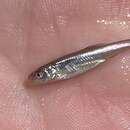pms
nòm ant ël fil


The spikedace (Meda fulgida) is an endangered species of ray-finned fish in the family Cyprinidae. It is found in Arizona and New Mexico in the United States. It lives in fast-moving streams.
The maximum length of the spikedace rarely exceeds 7.5 cm.[2] It usually has a slender body, with a somewhat compressed front, and is strongly compressed at the caudal peduncle, with a fairly pointed snout and contains a slightly subterminal mouth with large eyes. The dorsal fin origin is behind the pelvic fin origin. The scales are present only as small, deeply embedded plates. The first spinous ray of the dorsal fin is the strongest and most sharp-pointed. The spikedace has seven dorsal fin-rays and typically 9 anal fin-rays. The spikedace skin is olive-gray to light brown above, with a brilliant silver side, often with blue reflections, and with black specks and blotches on the back and upper side. The breeding male has a spectacular, bright, brassy yellow head and fins.[3]
Historically, the M. fulgida was common and locally abundant throughout the upper Gila River basin of Arizona and New Mexico. In Arizona, this included the Agua Fria, San Pedro, and San Francisco River systems, and the Gila, Salt and Verde Rivers and major tributaries upstream of present-day Phoenix. In New Mexico, it included San Francisco River, Gila River, and the East, Middle and West Forks of the Gila.
Presently, the species is found in Aravaipa Creek, a tributary of the San Pedro River, Eagle Creek, and the upper Verde River system in Arizona, and the upper Gila River system in New Mexico.[4]
The spikedace occupies midwater habitats of runs and pools,[5] and prefers moving in water less than 1 m deep and in a current of 0.3-0.6 m/s. The spikedace concentrates in the downstream ends of rivers, although many have been collected in the upstream portions of shear zones less than 0.33 m deep. In larger streams, the spikedace is found only at the mouth of creeks.[6]
The spikedace was formerly widespread in the Gila basin, but has suffered marked reductions in range in the last few decades. In areas where it still persists, it seems far less abundant now.[7] This species often declines and explodes in numbers.[8] Kirk Young (AGFD Native Fish Diversity Review 1995) reported four populations in Arizona. Paul Marsh[9] believes a population may be found in the White River which has not yet been surveyed.
Activities known to be detrimental to the spikedace are the removal of water from their habitats, stream impoundment, channelization, domestic livestock grazing, timber harvesting, mining, road construction, polluting, and stocking non-native species.
Threats to the species include stream flow depletion; diversion; habitat alteration and competition with non-native crayfishes; and predation by and competition with non-native fishes, especially red shiner.
{{cite web}}: CS1 maint: archived copy as title (link) The spikedace (Meda fulgida) is an endangered species of ray-finned fish in the family Cyprinidae. It is found in Arizona and New Mexico in the United States. It lives in fast-moving streams.
Meda fulgida Meda generoko animalia da. Arrainen barruko Actinopterygii klasean sailkatzen da, Cyprinidae familian.
Meda fulgida Meda generoko animalia da. Arrainen barruko Actinopterygii klasean sailkatzen da, Cyprinidae familian.
Meda fulgida è un pesce d'acqua dolce appartenente alla famiglia Cyprinidae, sottofamiglia Leuciscinae, nonché unico rappresentante del genere Meda[1].
Questa specie è diffusa nel bacino idrografico del fiume Gila in Nordamerica (Nuovo Messico e Arizona), dove abita piccoli torrenti, ruscelli, polle e laghetti con fondali rocciosi e sabbiosi.
Presenta un corpo sottile e allungato, idrodinamico, compresso ai fianchi; possiede occhi grandi, muso arrotondato, pinne trapezoidali. Il primo raggio della pinna dorsale è spesso e robusto. La livrea prevede un fondo argenteo, con dorso brunastro e ventre argenteo: lungo i fianchi corre una fascia orizzontale giallo dorata, più o meno screziata da minuti e fitti puntini bruni. Le pinne sono tendenzialmente trasparenti o giallo vivo.
Raggiunge una lunghezza massima di 9 cm.
La fecondazione è esterna, le uova sono deposte sul fondo e abbandonate al proprio destino.
Meda fulgida è stata inserita nella Lista Rossa IUCN fin dal 1986, a causa della ridotta area di origine e della competizione con specie aliene introdotte nelle acque dolci dove vive[2].
Meda fulgida è un pesce d'acqua dolce appartenente alla famiglia Cyprinidae, sottofamiglia Leuciscinae, nonché unico rappresentante del genere Meda.
Meda fulgida is een straalvinnige vissensoort uit de familie van de eigenlijke karpers (Cyprinidae).[2] De wetenschappelijke naam van de soort is voor het eerst geldig gepubliceerd in 1856 door Girard.
Bronnen, noten en/of referenties
Meda fulgida é uma espécie de peixe actinopterígeo da família Cyprinidae.
Pode ser encontrada nos seguintes países: México e nos Estados Unidos da América.
Meda fulgida é uma espécie de peixe actinopterígeo da família Cyprinidae.
Pode ser encontrada nos seguintes países: México e nos Estados Unidos da América.
Meda fulgida là một loài cá vây tia trong họ Cyprinidae. Nó được tìm thấy ở México và Hoa Kỳ. They usually live in fast moving streams.
Chiều dài của chúng hiếm khi vượt quá 7,5 cm [1].
Meda fulgida là một loài cá vây tia trong họ Cyprinidae. Nó được tìm thấy ở México và Hoa Kỳ. They usually live in fast moving streams.
光鱥(学名:Meda fulgida)为輻鰭魚綱鯉形目鲤科的其中一種,被IUCN列為次級保育類動物,分布於北美洲美國亞利桑納州及新墨西哥州,體長可達9.1公分,棲息在砂石底質的小溪或水塘。